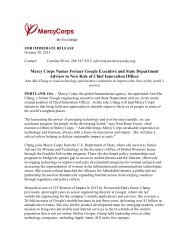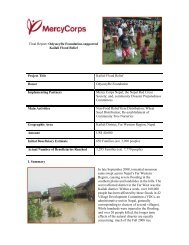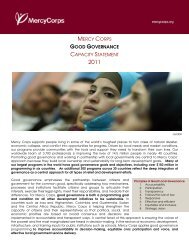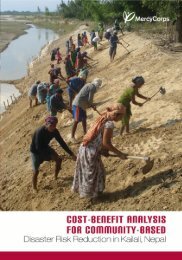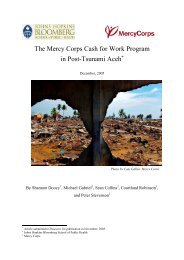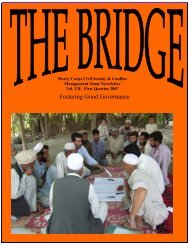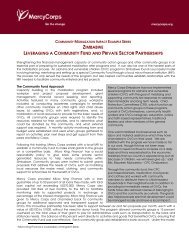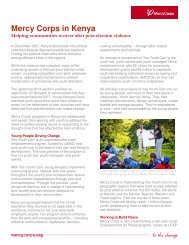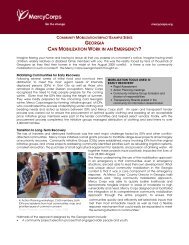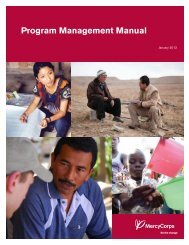SUSTAINABILITY FIELD STUDY - Mercy Corps
SUSTAINABILITY FIELD STUDY - Mercy Corps
SUSTAINABILITY FIELD STUDY - Mercy Corps
You also want an ePaper? Increase the reach of your titles
YUMPU automatically turns print PDFs into web optimized ePapers that Google loves.
Participation in Community Meetings and DecisionsNearly half of all general community member and youth respondents (49%) said that they hadattended at least one community meeting so far this year, and 39% have attended more than one(see Figure 7). Respondents who were participants in at least one <strong>Mercy</strong> <strong>Corps</strong> activity were alsomore likely to have attended community meetings, with 67% reporting attendance this year. Teachersand government employees were particularly likely to attend (see Table 4). Further, 56% of youthand general community member respondents felt that they were either fully involved in all aspects ofdecision-making and action (32%) or that they at least had some influence on the decisions madeby others (24%). However, even in these communities, there continue to be disparities between thelevels of participation and empowerment experienced by men and women. Men were much more likelyto have attended community meetings, with 65% having attended one this year as opposed to 33%among women.Figure 7: Attendance at Community Meetings in 200739%Attended NoneAttended 1Attended > 151%10%Table 4: Attended at Least 1 Meetingin 2007 by OccupationGovernment 75% Other 54%Teacher 71% Farmer 48%Doctor 63% Business 43%Trade/Technical 59% Student 38%Unemployed 57% Housewife 26%B. Recommendations1. Promote an inclusive process to select respected change agents.Building the skills of strong leaders can boost a community’s ability to take initiative and actcollectively. Conversely, empowering leaders who crave personal gain and/or lack community trust canhold communities back. The careful selection of trusted leaders is a critical part of the mobilization processand must include wide participation through anonymous voting to ensure that trusted individualsare selected. Programs should be cautioned not to rely too heavily on traditional leadership structures,such as the Mahalla and Aiyl committees in Central Asia, for identifying potential change agents. <strong>Mercy</strong><strong>Corps</strong>’ evaluation of the USAID-funded Community Revitalization through Democratic Action Program(CRDA) reached a similar conclusion: “When deciding on the initial community representatives, assurethat these include individuals who hold high respect and esteem in their communities. If held in thisregard, the local representatives will have significantly more success in mobilizing their communities;decreasing skepticism about the assistance program; and increasing the level of local participation,including the willingness to provide cash and in-kind matching contributions.” 212. Allocate sufficient time and resources to guide initial project.Community mobilization programs should allow sufficient time and human resources to carefully guidethe process during initial implementation and may consider focusing initially on less expensive projectsthat require modest community investments and have a high likelihood of early success. This willfoster the confidence and interest of communities to graduate to more expensive priorities and greaterinvestments in later cycles. Building on initial success and community pride encourages repetition of21 Vukovic, Bosiljka. Project Assessment for Serbia CRDA Community Development Programming 2001-2004. <strong>Mercy</strong> <strong>Corps</strong>, May 2007.p. 26.22Sustainability Field Study



